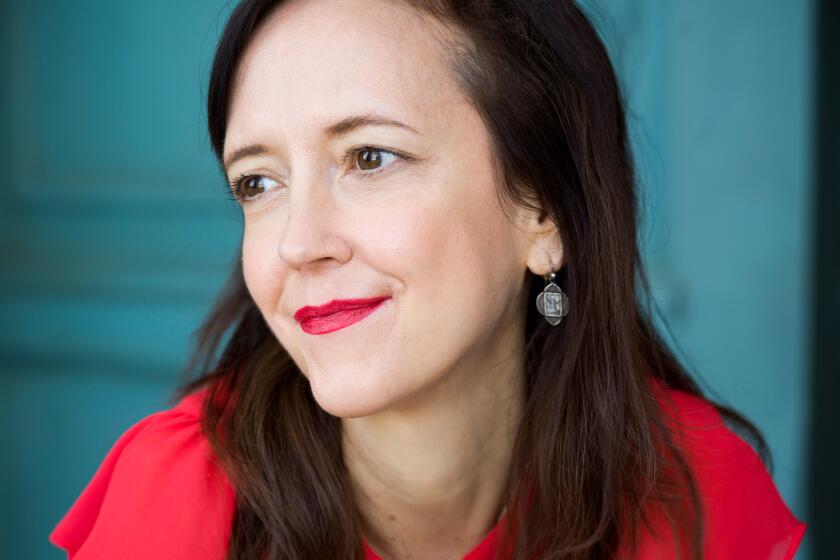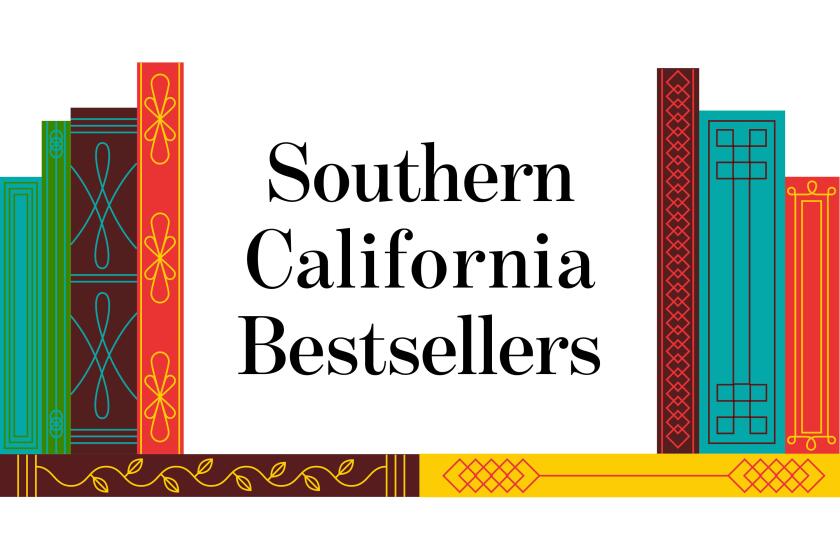From the Archives: Carolyn See, the poet laureate of Topanga Canyon
- Share via
Editor’s note: Novelist Carolyn See died July 13, 2016, at the age of 82.
Somewhere along the inner reaches of Topanga Canyon, not far from the ridge-top aerie where Carolyn See lives and writes, is a fading, hand-painted sign nailed to the trunk of an ancient oak tree: “This place defended by shotgun law.” And, sure enough, the sign and its ominous message show up on Page 194 of “Golden Days,” one of the novels that define See as not merely a California author but as the poet laureate of Topanga.
Topanga, rather like See herself, is one of those miracles of mother nature and human aspiration that seem to happen with particular frequency in California. The men and women in Carolyn See’s novels, again like the author herself, are drawn irresistibly to Topanga Canyon, a place of both sublime beauty and subtle danger, “the strange dank hollows and washed-out deltas . . . where clothing stores perched on creek banks and welfare mothers with sunny smiles watched their naked kids slushing in the mud.”
So it is fitting that Carolyn See’s rich and provocative body of work, so attuned to the hard realities of life in California, and yet so alive to its cosmic possibilities, is now recognized with the Robert Kirsch Award, an honor bestowed upon an author who writes about or lives in the West. See does both--and she does it with savvy, dark humor and an almost giddy sense of celebration that are rooted in the here-and-now of what California is, and yet reach toward the glittering dream of what California has always promised but rarely delivered.
See’s place in the literary firmament is to be found somewhere in a constellation of luminaries that includes Nathanael West and Joan Didion, Raymond Chandler and Charles Bukowski. Her own favorite author, See says, is E. M. Forster: “Forster figures, if you can muster up enough affection and enough passion,” explains See, “it’s still worth going on.” But we do not really need to compare Carolyn See to anyone else in order to figure out why her writing is so vivid and so affecting. Starting with “The Rest Is Done With Mirrors” (1970) and continuing through “Mothers, Daughters” (1977), “Rhine Maidens” (1981), “Golden Days” (1986) and her most recent novel, “Making History” (1992), See has given us a vision of the California that shimmers and glows with her own unique passion.
Carolyn See was born in Pasadena and grew up in a family afflicted with the economic and marital strife that forged her own courageous personality, sparked a sense of sharp irony and poignant humor, and--above all--inspired in See the conviction that writing well is the best revenge. “I’ve been at the very bottom of poverty, and it’s not so bad,” See once told an interviewer. “It’s even kind of interesting. You can live there with a certain amount of style.”
But See refuses to romanticize the experience of growing up poor in the Golden State. “It’s true I was born in poverty, in Los Angeles, and made a big deal out of it,” says Edith, the heroine of “Golden Days.” “California poverty. L.A. in the ‘40s. It has to do with one stunted fig tree in a postage-stamp back yard, and devil grass growing up six inches around the stucco (or peeling frame) garage. It had to do with chenille bedspreads, washed and washed until those pitiable little knots just keeled over on their side and died. It had to do with collecting the glasses that held processed cheese, and those were your glasses.”
See attended California State University at Los Angeles when it was still called, quaintly enough, the Los Angeles State College of Applied Arts and Sciences: “Twelve Quonset huts on a vacant lot in an East L.A. barrio,” as she writes in “Golden Days,” “and that was the best it ever looked.” Later, she earned her doctorate at UCLA, where she paid her dues as a scholar by writing a dissertation on the Hollywood novel, and started her academic career on the faculty at Loyola Marymount University. All the while, she was working hard to invent herself as a writer, the calling that beckoned her out of bad times and bad relationships.
“Support Your Local Author,” the license-plate frame on her car once read. “Buy My Book.” See’s life and work can be understood as a continuous act of self-definition and self-liberation: She is always looking for a way out and a way up, and so are the intrepid women in her books: “I had ambition, for what, I didn’t know,” says Edith in “Golden Days.” “It was a disease that had begun to afflict young women; a plague.” See survived two flawed marriages; she spent too long in exile in places like Newfoundland and Mazatlan and even Chinatown; she was called upon to raise two daughters, one from each marriage, as a single working mother. The experience, as we learn in her novels, was liberating, but excruciating, too.
“When the ‘60s had suggested they could ease up a little, smoke a little something at their back yard barbecues, Ruth panicked, and she had been right,” writes See about the divorced mother in “Mothers, Daughters.” “In sex, recorded music, this canyon cabin, their marriage unraveled, desisted, went. . . . Now that the decade’s panorama had been struck, she was left with its consequences. ‘It was all a trick!’ And about her marriage: ‘It was all a lie.’ The orderly world was a lie.”
See figured out how to impose a certain reassuring order on the chaos around her. She scratched out a living in the best tradition of the hardscrabble free-lance writer, crafting magazine pieces for everything from TV Guide to Sports Illustrated. She testified as an expert witness for the defense in obscenity prosecutions; the fee in her first case was supposed to be $50, but the defense attorney was so impressed by the fervor and wisdom of her testimony that he tore up the check and wrote out another one for $100. Out of that experience came “Blue Money” (1973), a study of the pornography business that also turned out to be an affectionate profile of her own father, who turned to writing pornography in his old age and cranked out 73 hard-core novels before his death.
See is always capable of surprising us, and she stubbornly refuses to be consigned to any of the niches reserved for women who write. She is not a “women’s” novelist or a “feminist” novelist or even a “California” novelist. Rather, she is unmistakably herself, a voice so distinctive and so authentic that her every word crackles with good humor and sings out with sheer joy, whether it’s in a novel, a book review, a lecture or an evening of conversation on the deck of her Topanga home, where she used to sleep on hot summer evenings until she found a rattlesnake under the chaise lounge.
See calls herself “a rabid feminist,” and yet, after the publication of “Rhine Maidens,” she announced: “I don’t think I’m interested in writing women’s novels anymore.” She has always resented the manifestations of a small mind or a mean spirit: “Until ‘Golden Days,’ ” See once complained, “(‘Blue Money’) was the only one of my books that men had ever read.” And she calls “Making History,” her latest novel, “both a love letter and an apology to the 97% of the men who don’t intend to blow up the world.”
See struggles, too, against the regional prejudices that still taint the publishing industry and the book review media: “Very much as men project weird fantasies on women, the people in New York project weird fantasies on California,” See once remarked. “I hope someday to see California literature become a part of mainstream American literature, and I hope to be part of that process.”
Still, Carolyn See has never renounced the place where she was born, the place where her novels are played out. Her books reflect the matter-of-fact multiculturalism of life in Los Angeles: “What do you want for breakfast?” asks an Anglo woman in “Mothers, Daughters.” “Cereal or quesadillas?” And she has a ready command of the iconography of the California dream: “To construct a perfect world, you needed beach,” See writes of the Pacific Rim entrepreneur who figures as a kind of hero in “Making History.” “As a Californian, Jerry knew that absolutely.”
And, rather than chiseling icy sociocultural constructs out of rock crystal or singing dirges of despair and dysfunction about life among the palms, See looks at Southern California in all of its squalor and excess and madness--and she sees the promise of redemption. Thus, for example, her novel of nuclear apocalypse in Southern California turns out to be a work of bracing optimism and even a kind of holy rosy utopianism.
“In its weird way,” wrote Carol Sternhell, backing into a compliment in a New York Times review of “Golden Days,” “this may be the most life-affirming novel I’ve ever read.”
Indeed, if there is one quality that continues to characterize See’s writing, it is a spiritual effervescence that bubbles up out of her prose, a sense that life may be a bitch, but there’s no point in bitching about it. “I’m in it for the laughs, cap and bells,” says a character named Robin (or, more precisely, the ghostly spirit of Robin) in “Making History.” “Trying to figure out what’s important, trying to separate what’s an errand from what’s having fun.”
It’s not that See plays the role of jester. See sees the moral landscape of California with perfect clarity, and she condemns hypocrisy, pretense, cruelty and stupidity wherever she finds them. Thus, for example, she lampoons the con-artist-turned-pop-guru-turned-drug-dealer in “Golden Days,” a man who espouses a money-is-love message (“ OOOeee ! I see abundance everywhere !”) and teaches his disciples to address each other as “You Radiant Being, You!” But she is still willing to entertain the notion that--somewhere, somehow--perfect happiness is attainable, if only we find the wisdom to trust ourselves and the courage to love one another.
“Throw yourself down !” says Thea, the unlikely seer of Simi Valley, in “Making History.” “Because you’re bound to go up , whatever you do!”
The polarities of See’s world can be defined by a few of her professional affiliations: the Modern Language Assn., the National Book Critics Circle, the Writers Guild. See is an English professor at UCLA, a book critic for the Washington Post (a recent move after years of reviewing in this paper) and a woman who knows how to pitch a story to a studio exec. She has reached cruising altitude as a novelist and has settled into a loving relationship with author and scholar John Espey--a marriage of true minds.
For all the humor in her books, there’s something more profound and more enduring at work here. Once she was invited by a radio interviewer to make up a list of the music that she would take along to a desert island. Among her favorites was Van Morrison, in particular a tune called “Rave On, John Donne.” See revealed that she listens to Van Morrison while writing because his music, so mystical and so ecstatic and yet so worldly-wise, induces an upwelling of creativity. It’s a revelation that explains a good deal about the terrain, so rich and so strange, that the reader encounters in a novel by Carolyn See.
“Rave on, John Donne,” Van Morrison sings. “Rave on, words on printed page.”
Rave on, Carolyn See. Rave on, You Radiant Being, You!
More to Read
Sign up for our Book Club newsletter
Get the latest news, events and more from the Los Angeles Times Book Club, and help us get L.A. reading and talking.
You may occasionally receive promotional content from the Los Angeles Times.









